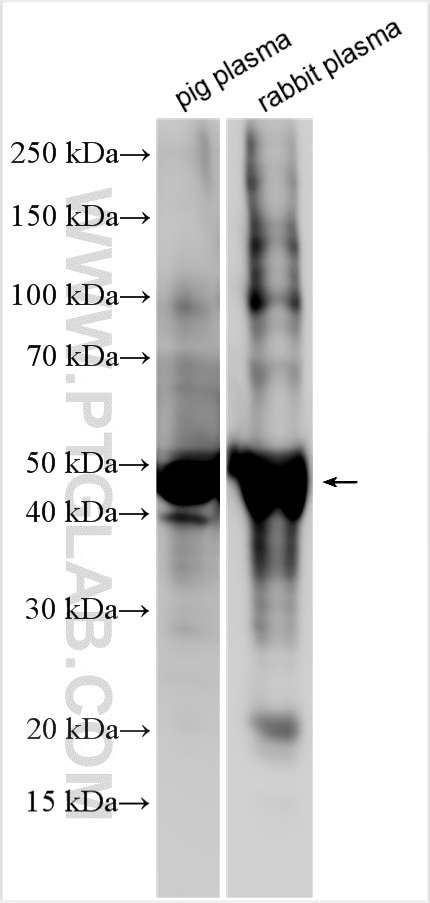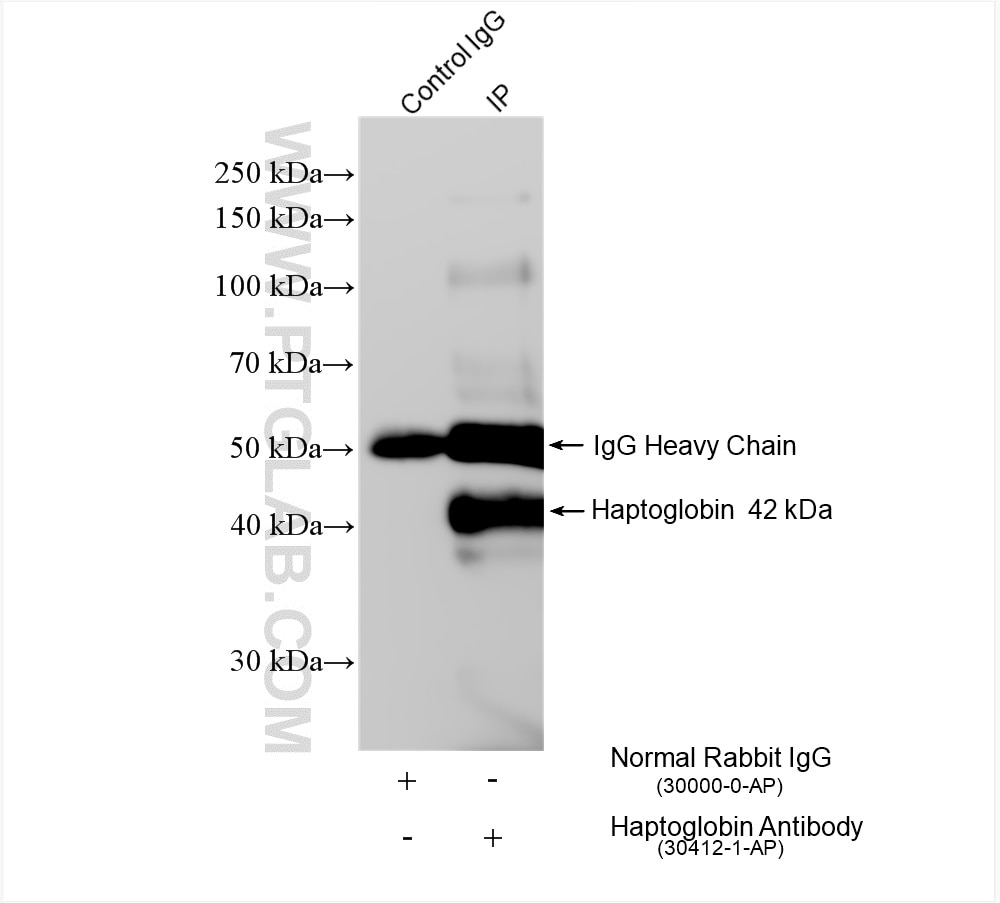Anticorps Polyclonal de lapin anti-Haptoglobin
Haptoglobin Polyclonal Antibody for WB, IP, ELISA
Hôte / Isotype
Lapin / IgG
Réactivité testée
Humain, Lapin, porc, rat
Applications
WB, IP, ELISA
Conjugaison
Non conjugué
N° de cat : 30412-1-AP
Synonymes
Galerie de données de validation
Applications testées
| Résultats positifs en WB | rabbit blood tissue, plasma de porc |
| Résultats positifs en IP | plasma humain, |
Dilution recommandée
| Application | Dilution |
|---|---|
| Western Blot (WB) | WB : 1:2000-1:12000 |
| Immunoprécipitation (IP) | IP : 0.5-4.0 ug for 1.0-3.0 mg of total protein lysate |
| It is recommended that this reagent should be titrated in each testing system to obtain optimal results. | |
| Sample-dependent, check data in validation data gallery | |
Informations sur le produit
30412-1-AP cible Haptoglobin dans les applications de WB, IP, ELISA et montre une réactivité avec des échantillons Humain, Lapin, porc, rat
| Réactivité | Humain, Lapin, porc, rat |
| Hôte / Isotype | Lapin / IgG |
| Clonalité | Polyclonal |
| Type | Anticorps |
| Immunogène | Protéine recombinante |
| Nom complet | haptoglobin |
| Poids moléculaire observé | 36-45 kDa |
| Numéro d’acquisition GenBank | BC121125 |
| Symbole du gène | HP |
| Identification du gène (NCBI) | 3240 |
| Conjugaison | Non conjugué |
| Forme | Liquide |
| Méthode de purification | Purification par affinité contre l'antigène |
| Tampon de stockage | PBS with 0.02% sodium azide and 50% glycerol |
| Conditions de stockage | Stocker à -20°C. Stable pendant un an après l'expédition. L'aliquotage n'est pas nécessaire pour le stockage à -20oC Les 20ul contiennent 0,1% de BSA. |
Informations générales
Haptoglobin is also named as Zonulin and belongs to the peptidase S1 family. Haptoglobin is an alpha-2-glycoprotein synthesized mainly by hepatocytes consisting of both alpha and beta subunits linked by disulfide bonds forming dimers (PMID: 4018023). Haptoglobin is primarily produced in the liver, and when red cells are lysed in vivo, free hemoglobin binds to circulating haptoglobin; the hemoglobin-haptoglobin complex is then degraded by the reticuloendothelial system (PMID: 24809098). Because haptoglobin levels become depleted in the presence of large amounts of free hemoglobin, decreased haptoglobin is a marker of hemolysis. The human haptoglobin (HP) gene exists in two major allelic forms leading to three major genotypes: Hp1-1, Hp2-1, and Hp-2-2, that separate on alkaline starch gel electrophoresis due to different molecular weights (PMID: 17474882). Their properties vary in binding strength, anti-oxidative ability, and rate of clearance. Binding strength is greatest with Hp1-1, but the Hp-2 genotypes can bind a larger number of hemoglobin alpha-beta dimers. Complexes of Hp2-2 and hemoglobin have higher affinity for the CD163 receptor, the monocyte-macrophage receptor that facilitates its clearance. Neutrophils contained a large amount of highly glycosylated Hp (β-chain 45-65 kDa) synthesized in neutrophil precursors and stored in specific granules and a small amount of Hp (β-chain 39 kDa) endocytosed from plasma and stored in secretory vesicles (PMID: 16543473).
Protocole
| Product Specific Protocols | |
|---|---|
| WB protocol for Haptoglobin antibody 30412-1-AP | Download protocol |
| IP protocol for Haptoglobin antibody 30412-1-AP | Download protocol |
| Standard Protocols | |
|---|---|
| Click here to view our Standard Protocols |




